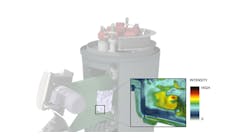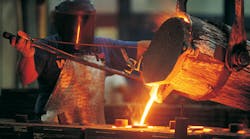Latest from Simulation/IT
As in much of manufacturing, the casting industry is in a state of flux with competition keen and producers fighting for precious contracts. OEMs and other primary component-makers using casting remain deeply interested in best cost and delivery. But as the stakes ratchet up, there is growing evidence that future success lies in the willingness of suppliers—be they larger foundry operations or smaller investment, sand, and die casting shops—to bring extra value to the quoting process and the supplier-customer relationship.
Over the years, casters have adopted a variety of practices for determining the cost of parts. A number of successful foundries and diecasters use detailed in-house spreadsheets that mirror their manufacturing processes and are built on quantified historical knowledge collected over years of practice. Many others, however, use a more subjective approach that relies on “general rules” and approximations, which simplify, or may even overlook, important factors such as setup labor, energy overhead, and tool wear.
We’ve all seen how reliance on inexact costing methods can lead to misquoting and undesirable consequences. For example, inflated bids—created to cover unknowns—can result in unnecessarily high quotes and lost business. Underbidding, which is also common, may produce wins but hurt the organization in the long run by bleeding its bottom line. Given the current competitive climate and basic business realities, there’s no room for sacrificing potential work or profit.
Negative outcomes can be avoided if the “black art” of costing is replaced by more quantitative methodologies: One design-for-manufacture approach is DFM Concurrent Costing, a software tool developed by Boothroyd Dewhurst, where I am R&D manager. Using this systematic, science-based DFM method, casting operation managers/owners are able to generate extremely accurate piece part and tooling cost estimates for designs that come “as is” from OEMs, or are modified by the casting house to show improvements.
Putting DFM into practice
Every design project starts with a host of manufacturing and material choices. Should the part or component be steel or alloy? What finish specs are required? Is machining, forging, or casting most cost-effective? And for what quantities? OEMs attempt to answer these questions early in the product development cycle. But, often the designs that reach the RFQ stage are still incomplete because the models are not fully cost-optimized for the casting process.
The DFM tool can help fill in the blanks for the design in question. Here’s how it works: When an RFQ arrives, basic part properties from the digital model are easily imported into the software. Using a guided series of questions, DFM then leads you through a calculation of every aspect of part cost, referencing information in the software’s machine library, materials database, and machine/operator rate tables. Product life volumes can be adjusted to illustrate cost-per-part as production volumes shift. Product dimensions and tolerances can be altered, too, so that noteworthy cost implications related to problems or design changes become clear and can be discussed.
When the situation warrants, DFM also can be used to help determine whether the chosen casting process and material are the most cost effective for the given geometry and spec—a useful capability for those casters who are full-service providers and offer, or outsource, other fabrication methods in addition to casting. Using the same extensive libraries of industry data, the software allows you to investigate various fabrication process and material choices, making quick comparisons at different production levels (see p.11, “DFM Concurrent Costing: An Example”.)
In the best of worlds, the DFM process would be applied to concept-stage geometries, upfront in the design cycle where changes are easy to make (rather than once CAD models are finalized.) At this early stage, by entering rough part dimensions into the software’s geometry calculator, the tool can help widen design possibilities and assist engineers sorting through the difficult design trade-offs. It’s not likely this option would be possible for casting suppliers, of course, unless buyers are receptive to feedback. Or, OEM-supplier relationships have been tested and deepened by cost transparency and knowledge exchanges, an area where suppliers excel.
To improve the cost of new and redesigned products, the DFM module can be coupled with Design for Assembly (DFA) Product Simplification software. The focus of this program is to reduce part count (a perfect complement to casting), decrease assembly times, improve performance and quality, and lessen warranty and service issues. Together, the two-part methodology (called DFMA™) results in total cost and product optimization, complementing lean and value engineering initiatives.
Drilling down into casting cost details
When a competitive bid arrives, casting estimators immediately want to know: What are the major cost drivers for this part? OEMs responsible for the designs are often equally curious. Using DFM methods the software will isolate the most expensive features for review. There’s no need for “guestimates” at any stage of the effort.
Labor — Labor is one of the major expenses for any casting project. For example, with certain types of expendable-mold casting processes, such as sand or investment, labor costs can be extremely high when producing low volumes—more than the material cost in some cases. To calculate the total input, the software prompts you to tally the time required for the moldmaking process, the labor needed for pouring the metal (which varies according to the volume required for the part), plus the hours required to remove the part from the mold and clean it. Finally, the tool applies the wage of a typical North American foundry worker (a default value that can be changed) and adjusts for plant efficiency (a metric specific to each facility.) In this way, the DFM software leads you through all of the manufacturing steps so that important labor contributions are not overlooked.
Materials— For any casting process, the amount of material required to make the component is significantly larger than the volume of the finished part itself. This explains why the cost of the metal to be cast — e.g., iron, aluminum, magnesium, zinc, steel, or copper-based alloys — can represent an important portion of the total piece-part cost. With some sand castings, for instance, you need twice as much material as will end up in the finished piece. Using built-in material/process databases, the DFM tool allows you to calculate an accurate raw metal total for any type of casting operation, as well as for other competing processes.
Setup— There is time associated with setting up machinery to cast any part, regardless of batch size and life volume. But, the setup expense can only be amortized among the parts being made. So, if you’re producing cast parts in low volume, the calculation of setup costs becomes pivotal in making process comparisons and decisions about the most economical manufacturing process.
For prototype volumes (of one or two, let’s say), the setup cost per part for casting can be very high. As volumes increase, the cost per part goes down. DFM software captures these setup costs and their dynamic contribution to overall cost as product volumes fluctuate, and can create graphics of this data that are useful in negotiations.
Tooling— The cost of tool wear during machining can be estimated based on the tool material required, the part material being cut, and the specific process. This calculation is performed using values from the Taylor Tool Life Index, which are included in a DFM database. For a pattern or mold, the software specifies values for pattern/cavity life—or the number of castings that can be made before it wears out or needs reworking. With investment casting, for example, if you’re making wax, rather than plastic patterns, the tools will last a bit longer. DFM-led queries about tool wear help you assemble an accurate detailed view of all tooling costs.
Energy — To get a handle on energy’s contribution to part cost, the DFM process can be used to determine exactly how many kilowatt-hours are required to melt the metal needed to make the part. The software calculates this figure by first quantifying the temperature increase necessary to heat the specified metal from room temperature to the pouring point, and then factoring in both furnace efficiency and the electricity rate. Applying the DFM tool to quantify the energy expense inherent in a cast part is of increasing importance, given the fact that energy rates have been volatile and trending upwards.
When an analysis is complete, the DFM methods will have generated detailed data about cost structure, while also pointing you toward the most cost-effective product/part designs. Armed with such cost breakdowns, you will be able to provide science-based proof to potential customers that your shop’s manufacturing processes are the most competitive—or suggest an alternative process that you can help manage.
How scientific costing can help metalcasters
Over the past five years, the American Foundry Society (AFS) reports that the number of metalcasting facilities in the U.S. has decreased about 14 percent, from 2,336 to 2,010. This trend punctuates a 50-plus year decline and has been attributed to factors including the recession, technological advances, tightening regulations, and foreign competition.
Yet, while the number of casting operations shrinks, opportunities in the industry still abound: U.S. metalcasters shipped approximately $30 billion in product in 2011 (also according to AFS.) That robust total, along with the prevalence of cast parts in established industries such as oil and gas, mining, and automotive, illustrates that there is still money to be made. To remain competitive, though, casters and foundries will need to sharpen their pencils, estimates and costing methods.
As small- to medium-sized metalcasters consider revamping their costing process, the obvious question is: “What’s in it for me?” The benefits are many.
For one, DFM-driven costing can help eliminate subjective ballparking and unexpected manufacturing surprises. It can also illuminate the most competitive manufacturing path to take in the quest for market-leading, cost-optimized products. And finally, quoting transparency (a byproduct of DFM methods) can help shift the supplier-customer relationship from a traditional adversarial tone to one of collaboration.
As manufacturing enters the collaborative age, enough can’t be said about the added value of having suppliers involved in costing conversations as early as possible in the part/product design process. At Boothroyd Dewhurst, we continue to see examples of agile suppliers, both large and small, who have incorporated scientific costing methods into their work and, as a result, are bringing value to the supply chain and enjoying tremendous growth.
Brian Rapoza is a developer of DFMA software with Boothroyd Dewhurst, where he has been the R&D manager since 2000. Contact him at [email protected]. For more information on DFM Concurrent Costing, visit www.dfma.com/software/dfm.htm.









